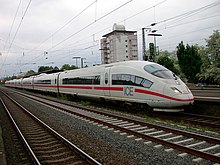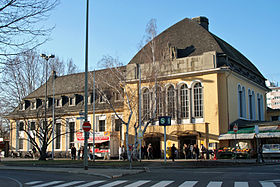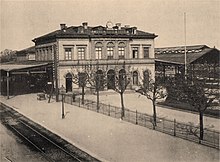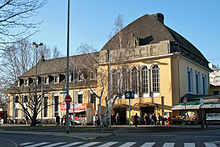Frankfurt-Höchst train station
| Frankfurt-Höchst | |
|---|---|
| Data | |
| Design | Through station |
| Platform tracks | 12 |
| abbreviation | FHOE |
| IBNR | 8000106 |
| Price range | 3 |
| opening | 1839 (reception building from 1914) |
| Profile on Bahnhof.de | Frankfurt-Hoechst |
| Architectural data | |
| Architectural style | Art Nouveau |
| location | |
| City / municipality | Frankfurt am Main |
| Place / district | Maximum |
| country | Hesse |
| Country | Germany |
| Coordinates | 50 ° 6 '9 " N , 8 ° 32' 33" E |
| Railway lines | |
|
|
| Railway stations in Hessen | |
The Frankfurt-Höchst train station is located in the Höchst district of Frankfurt and, with twelve platform tracks, is the second largest train station in the Main metropolis. Its importance today is primarily in the S-Bahn , suburban and regional traffic . It is the most important public transport hub in western Frankfurt.
history
First train station
development
The first Höchst station was built with the construction of one of the first railways in Germany . On September 26, 1839, only four years after the opening of the line from Nuremberg to Fürth , the first section of the Taunus Railway opened , running from the Taunus station in Frankfurt almost nine kilometers to Höchst. The first Höchst station was 400 meters east of today's station, on Königsteiner Strasse .
The second railway line leading to Höchst was the short Soden Railway in 1847 , the first branch line in Germany. It connected the nationally important health resort Bad Soden with the rest of the world via Höchst. Only in 1877 was followed by the much more important Main-Lahn Railway according Eschhofen and Limburg , by the Hessian Ludwig Railway was built across the Taunus runs and a connection to the Lahn Valley Railway casting - Koblenz created. In the course of the increasingly extensive traffic, this first station was rebuilt and expanded several times.
First and second reception building
The reception building was not yet completed when it opened - and also in 1842. Initially, a wooden temporary structure was used.
The final station building came from the Mainz architect Ignaz Opfermann , who designed all the high-rise buildings along the Taunus railway. It was a "type building" that sacrificemann used several times here along the route and later also along the Hessian Ludwig Railway from Mainz to Worms : A two-story gable - independent central building is accompanied on both sides by an eaves , single-story side wing, all components each have a saddle roof . On the ground floor, arched doors and windows characterize the picture, while the windows on the upper floor are rectangular.
Second train station
development
In 1880 a completely redesigned station was opened. The occasion was the opening of the Main-Lahn-Bahn and, in 1880, its extension via Griesheim and Nied to the municipal connecting line in Frankfurt am Main , which in turn merged into the Frankfurt – Hanau line , which was also part of the Hessian Ludwigsbahn network. The old system was too small for the traffic it generated. The station was built as an island station between the Limburg Railway (in the south) and the Taunus Railway (in the north), west of Königsteiner Strasse. The road side access was from there via a cul-de-sac.
In 1902 the Frankfurt-Königsteiner Eisenbahn opened its operations via Kelkheim to Königstein , so that now six lines led to the Höchst station, three from the east and three from the west. Since September 1, 1905, the Kaiserkurve from the direction of Rödelheim was added, initially only used by special trains , etc. a. the court train of Kaiser Wilhelm II and freight trains , from 1908 also regular passenger trains, including an express train from Berlin to Wiesbaden via Bad Nauheim and Bad Homburg (see also: Bäderbahn Bad Nauheim-Wiesbaden ). The train station of the town of Höchst am Main, which was independent until April 1, 1928, was now a traffic junction whose train station had to be expanded further.
Third station building
The station building was built by the architect and royal railway and operations inspector Heinrich Velde , who built a total of 37 stations in the Rhine-Main area , of which the Höchst station is considered to be its architectural masterpiece.
Third station
development
The entire traffic system - previously operated at street level - was raised. This new plant was put into operation in 1914 without being able to be completed initially due to the First World War :
Fourth reception building
The new reception building with echoes of Art Nouveau was not completed until 1920. Architects were Ernst Kleinschmidt and Armin Wegner . Today it is a cultural monument due to the Hessian Monument Protection Act . The station was named Höchst (Main) Hauptbahnhof on May 15, 1927 and - after the incorporation in 1928 - the name Frankfurt (Main) -Hoechst .
Status
Today nine tracks are used regularly. The reception hall from 1914, which is representative in itself and influenced by Art Nouveau , looks depraved. There is a bookstore and a travel center operated by Deutsche Bahn AG (DB) , as well as a kiosk , a café and an Italian delicatessen . There are also sanitary facilities in the lobby , which were closed in 1993 due to repeated damage from vandalism, but reopened in March 2006.
Apart from the nearby Frankfurt Education and Culture Center , which houses the Friedrich-Dessauer-Gymnasium and an adult education center, whose students benefit from the good transport connections, the area north of the train station is a residential area.
The main entrance to the station is on the south side. To the west of the reception building is a bus station from which you can currently drive to the districts of Sindlingen , Zeilsheim , Nied , Griesheim , Bockenheim , Schwanheim , Niederrad , Sossenheim , Rödelheim and Unterliederbach as well as to Frankfurt am Main Airport . There are also buses to the neighboring cities of Sulzbach , Bad Soden, Königstein and Eschborn .
The Bruno-Asch-Anlage, which was built in the 1920s , extends along the railway line between the Höchst train station and Dalbergplatz . It is one of the few expressionist gardens in Germany. Little was left of its original state until the end of 2010. The park and the associated Seiler fountain have been restored since 2011 after some extensive restoration.
Modernization of the train station
The pedestrian underpass received a floor covering with natural stone slabs. In addition, a so-called curtain wall was installed in the underpass . The north exit of the pedestrian underpass was given a sloping entrance so that the previous steps could be dispensed with. The historical columns there were covered with mosaic.
The staircases west of the pedestrian underpass for platforms 1 to 3 and 5 have been widened and an elevator system has been added in the middle . Some staircases have been restored in their historical form with white and green tiles and curved handrails in accordance with listed buildings . On platform 6, the western staircase was renewed without widening, as the associated elevator system was installed opposite, dispensing with a second staircase.
Platforms 4, 5 and 6 have been increased to 76 centimeters for stepless entry and exit. Most of the platforms used for passenger transport have been given new coverings and a tactile guidance system for people with visual impairments. The platform roofs were renewed after it turned out that the old ones were too dilapidated for renovation.
The modernization work was largely completed by the end of 2017.
Redesign of the station forecourt
The northern station forecourt was redesigned in 2014.
In particular, road crossings and entrances to the train station were barrier-free , the number of covered bicycle spaces was increased and the area at the entrance to the underpass was redesigned. The square was completely paved with natural stones and houses several retractable and therefore space-saving glass containers for the residents. The costs for the renovation of the northern station forecourt, which is entirely owned by the city, amount to 1.2 million euros.
The redesign of the southern station forecourt was completed in 2020.
This means that Adolf-Haeuser-Strasse and Dalbergstrasse can now be used in both directions. In the eastern terrain were park - & - ride sites , as well as the taxi stands rebuilt. A modern, central bus station was inaugurated on the western side of the forecourt in December 2018 and serves nine bus routes. The forecourt was suitably covered with a new paving, which is intended to create a connection to the listed station building.
The planning and development of the so-called blackberry biotope, a fallow area between the bus station and the train tracks, is still open . In addition, the reception building is still in a listed but unsightly condition. The costs for the redesign of the southern station forecourt amount to almost 5 million euros, of which 1.9 million euros were borne by the state of Hesse.
Rail operations
meaning
The Höchst train station is still a hub for urban rail traffic in the west of Frankfurt. Nevertheless, it has lost a lot of its importance for regional traffic. Apart from the S-Bahn and the suburban trains of the Frankfurt-Königsteiner Eisenbahn (FKE), only four Regional Express and three regional train lines stop in Höchst . In the past, Höchst was also a stopping point for long-distance traffic , especially for express trains . With the opening of the first airport train station in 1972, long-distance rail transport began to be relocated from the Taunus railway north of the Main to the south Main route via the stadium , airport, Rüsselsheim and Mainz .
Regional traffic

Four regional express and five regional rail lines are left of the once numerous express and D trains that stop at Höchst . Eight of these lines start at the main station and, in addition to the S-Bahn, offer an alternative connection between Höchst and the main station, which is mainly used by commuters.
| line | route | Tact |
|---|---|---|
| RE 4 | Frankfurt (Main) - Frankfurt-Höchst - Mainz - ( Worms - Frankenthal (Pfalz) - Ludwigshafen (Rhein) Hbf - Schifferstadt - Speyer - Germersheim ) | 120 min |
| RE 9 | Frankfurt (Main) - Frankfurt-Höchst - Mainz-Kastel - Eltville | Two pairs of trains |
| RE 14 | Frankfurt (Main) - Frankfurt-Höchst - Mainz - Worms - Frankenthal (Palatinate) - Ludwigshafen (Rhine) center - Mannheim | 120 min |
| RE 20 | Frankfurt (Main) - Frankfurt-Höchst - Hofheim - Niedernhausen - Idstein - Bad Camberg - Limburg | 60 min (Mon-Fri, only peak hours) |
| RB 10 | Frankfurt (Main) - Frankfurt-Höchst - Mainz-Kastel - Wiesbaden - Eltville - Rüdesheim - Koblenz - Neuwied | 60 min 30 min (HVZ) |
| RB 11 | Frankfurt-Höchst - Sossenheim - Sulzbach - Bad Soden | 30 min 60 min (Sun) |
| RB 12 | Frankfurt (Main) - Frankfurt-Höchst - Liederbach - Kelkheim - Königstein | 30 min 60 min (Sun) |
| RB 21 | Frankfurt (Main) - Frankfurt-Höchst - Hofheim - Niedernhausen - Idstein - Bad Camberg - Limburg | individual trains |
| RB 22 | Frankfurt (Main) - Frankfurt-Höchst - Hofheim - Niedernhausen - Idstein - Bad Camberg - Limburg | 60 min 30 min (HVZ) |
- The line RE 4was introduced for the 2018/19 timetable change and runs from Frankfurt every almost two hours via Hochheim and the Mainz bypass to Mainz Hauptbahnhof. One of these will be extended to Germersheim during peak hours. The ones coming from KarlsruheRE 4run every two hours. This tractive effort belongs to the SÜWEX network .
- The line RE 9was introduced for the 2018/19 timetable change and offers commuters two trains in the morning to Frankfurt and one train each in the morning and one in the afternoon to Eltville . It does not stop at Wiesbaden main station, but only in Mainz-Kastel. This tractive effort is operated by VIAS . The route traveled is otherwise the same as the RB10.
- The line RE 14was introduced at the 2018/19 timetable change and runs to Mainz via the Mainbahn and then via the Mainz-Mannheim line to Mannheim. It also belongs to the SÜWEX network and runs every two hours in both directions.
- The line RE 20runs on weekdays (except Saturdays) along the Limburg Railway via Hofheim and Niedernhausen to Limburg, with the trains between Niedernhausen and Limburg only stopping in Idstein, Bad Camberg, Niederbruch and Eschhofen .
- The line RB 10 (RheingauLinie) runs via Wiesbaden and Koblenz to Neuwied, using the Taunus Railway and the right-hand Rhine route . Until the 2010/2011 timetable change , this line operated under the name RE 10 (Loreley Express) every two hours. In addition, there were individual connections on the RB 10 line (Loreley Railway) during rush hour . Until December 11, 2010, the RE / RB 10 lines were operated by Deutsche Bahn AG . On December 12, 2010 VIAS GmbH took over operations on this line and renamed it SE 10 (RheingauLinie) . The line has been operating again as the RB 10 since December 11, 2016.
- The line RB 21runs on the same route as the RE 20 line to Limburg. It replaces a train service at night and is operated by the Hessische Landesbahn.
- The line RB 22Also operates like the RE 20 line. This line stops at every train station between Niedernhausen and Limburg. The line has been operating as RB 22 since December 11, 2016, before that as SE 20.
Koenigstein Railway
The RB 12is a private railway that runs over the single-track route from Königstein im Taunus via Kelkheim and Liederbach to Höchst. While the FKE trains only shuttled between Königstein and Höchst until they were accepted into the FVV and passengers destined for Frankfurt-Stadtmitte were forced to change to the S-Bahn, since then the trains have been running directly to the main station again without any further stops. It runs every 30 minutes, similar to the S-Bahn, but only every 60 minutes on Sundays. In addition, every second train is recorded as aRB 15 extended to Brandoberndorf after stopping at Frankfurt Central Station.
Soden Railway
The RB 11was created through the outsourcing of ![]() the Sodener Bahn , due to low utilization. Thus this route was transferred to the FKE (today HLB). Coming from the north-west and north-east, the Königsteiner and Sodener Bahn merge a few hundred meters in front of the train station into the track apron of the Höchst train station.
the Sodener Bahn , due to low utilization. Thus this route was transferred to the FKE (today HLB). Coming from the north-west and north-east, the Königsteiner and Sodener Bahn merge a few hundred meters in front of the train station into the track apron of the Höchst train station.
Train
Two lines of the S-Bahn Rhein-Main run via Höchst: the S1 line, coming from Wiesbaden via the Taunus-Eisenbahn, entering the inner city tunnel just before the main station and driving under the Main, it takes the tunnel that branches off to the east in Sachsenhausen , which after a short above-ground section crosses the Offenbach city center and continues over the Rodgaubahn to Rödermark - Ober-Roden .
The S2 line begins in Niedernhausen im Taunus on the Limburg Railway, where a branch line branches off to Wiesbaden , follows the Limburg Railway via Eppstein and Hofheim and meets the Taunus Railway and the S1 in the area of the former Höchster Güterbahnhof ( Farbwerke S-Bahn station ) . From there it runs together with the latter through the inner city tunnel to Offenbach-Bieber station , from where it continues via Heusenstamm to Dietzenbach and ends there.
In addition, there are reinforcement trains coming from the main station that end in Höchst (S1). Together with these, the section between Höchst and the city center takes about ten minutes. The travel time to the main station is only ten (two intermediate stops) and to the center of the city, the Hauptwache , about thirteen minutes.
planning
Regional bypass West
The planned regional light rail “ Regional Tangente West ” (RTW) could become very important for the future of the Höchst station .
Although there is only five kilometers between Höchst and the airport terminals, there is no direct rail link between these two locations. The railway line, which should lead from the north-west town or Bad Homburg via Eschborn to Höchst, would lead from there over the Leuna bridge to the airport and on to Neu-Isenburg . The airport could be reached from Höchst in a few minutes' drive, a considerable advantage for the Höchst location.
In the area around Höchst station, the RTW would enter from the north-east via the Sodener Bahn and exit in the south via a tram line to be built along the Leunastraße. The exact route is still unclear, and a variant through the Höchst industrial park is under discussion.
tram
The connection to the Frankfurt tram , which was promised to the city of Höchst in the incorporation contract of 1928 , was implemented in 1952. However, the tram only travels one block in the Höchst area to its terminus on Zuckschwerdtstrasse. An extension at least to the train station has been under discussion since then.
In addition to a tour of the tram through the narrow streets of the Höchst city center, due to the low utilization of some platform tracks, an introduction of the tram into the track field of the station is also being discussed. Concrete plans are not yet available.
Occupancy of the tracks and platforms
- Platform track 1/2 : S-Bahn towards the city center, regional trains and regional express trains from Limburg to Frankfurt
- Platform track 3/4 : S-Bahn towards Wiesbaden / Niedernhausen , regional train train to Limburg (via Höchst Farbwerke ; platform 3)
- Platform 5/6 : Regional trains from and to Wiesbaden / Koblenz / Neuwied
- Platform track 7 : Regional express trains to Mainz / Mannheim
- Platform 8/9 : feed to the external cleaning system for ICE trains, freight trains
- Platform track 10/11 : regional train and regional express trains to Limburg (track 10), Sodener Bahn (track 11) (HLB)
- Platform track 12/13 : Königsteiner Bahn to Königstein (track 13) and to the main station (track 12) (HLB)
ICE treatment, freight yard
To the west of the passenger station are the extensive tracks of the former freight station . It was the central transshipment point in the west of Frankfurt and was shut down in the 1990s. Since then, a high-performance interior and exterior cleaning system for ICE trains has been built in the area of the freight station.
The interior cleaning system consists of two tracks on which ICE trains (including regional trains during the day) are cleaned around the clock.
Inking unit stop
On the southern edge of the freight yard, near the North Gate of the then Farbwerke Hoechst AG , a stop at Farbwerke Hoechst was established in 1967 . Since 1978 it has been a station on the S-Bahn lines S1 and S2. It has a single central platform and a long access tunnel to the factory premises. The name was changed to Frankfurt-Höchst Farbwerke after the dissolution of Hoechst AG .
| Rhein-Main S-Bahn | ||
| Previous station | line | Next station |
|---|---|---|
|
Höchst Farbwerke ← Wiesbaden Hbf |
|
Nied Rödermark-Ober-Roden → |
|
Höchst Farbwerke ← Niedernhausen |
|
Nied Dietzenbach train station → |
See also
Web links
- Station board of Frankfurt-Höchst station: current departures
literature
- Ferdinand von Rüden: Frankfurt am Main transport hub. From the beginning until around 1980 . EK-Verlag, 2012, ISBN 978-3-88255-246-1 , p. 78f.
- Heinz Schomann : Railway in Hessen . Railway history and building types 1839–1999 / Railway buildings and lines 1839–1939. In: State Office for Monument Preservation Hessen (Ed.): Cultural monuments in Hessen. Monument topography Federal Republic of Germany . Three volumes in a slipcase. tape 2.1 . Theiss Verlag, Stuttgart 2005, ISBN 3-8062-1917-6 , p. 34 .
Individual evidence
- ↑ Query of the course book route 646 at Deutsche Bahn.
- ↑ Query of the course book route 627 / 645.2 at Deutsche Bahn.
- ↑ Query of the course book route 643 at Deutsche Bahn.
- ↑ Query of the course book route 645.1 at Deutsche Bahn.
- ↑ Schomann, p. 35.
- ↑ Lichthammer: About some train stations in western Germany and Belgium. In: Allgemeine Bauzeitung. 7, Vienna 1842, pp. 354-363 (360).
- ↑ Schomann, p. 34.
- ↑ Silvia Speckert: Ignaz Opfermann (1799–1866): Selected examples of his construction activity in the vicinity of the city of Mainz = housework to obtain the academic degree of a Magister Artium. Johannes Gutenberg University , Mainz 1989. Volume 1: Text, Volume 2: Tafeln. Mainz City Archives, 1991/25 No. 11, p. 69.
- ↑ from males
- ↑ from males
- ↑ Schomann, p. 35.
- ↑ Schomann
- ↑ The fountain gushes in the Bruno Asch plant. (No longer available online.) In: Höchst Kreisblatt. July 3, 2013, archived from the original on May 23, 2014 ; accessed on May 23, 2014 .
- ↑ Elevators in the Höchst train station are mostly broken. In: Frankfurter Neue Presse. February 1, 2017, accessed September 21, 2017 .
- ↑ a b Half time at the Höchst train station.
- ↑ Heinz Wionski: PU Bahnhof Frankfurt-Höchst. In: Monument Preservation and Cultural History. No. 1, 2018, p. 10f.
- ↑ The Höchst station is right on schedule. In: Frankfurter Neue presse. March 10, 2015, accessed December 4, 2015 .
- ↑ Heinz Wionski: PU Bahnhof Frankfurt-Höchst. In: Monument Preservation and Cultural History. No. 1, 2018, p. 10f.
- ↑ The forecourt of the Höchst train station is finished. In: Frankfurter Rundschau. February 5, 2020, accessed May 15, 2020 .
- ↑ The eyesore was yesterday: The train station in Höchst was finally cleaned up. In: Frankfurter Neue Presse. February 7, 2020, accessed May 15, 2020 .
- ↑ Wilfried Staub “If not now, then when?” Preprint from the passenger newspaper PRO BAHN Hessen No. 86 - May / June 2011, accessed on October 30, 2011 (PDF file; 493 kB)







